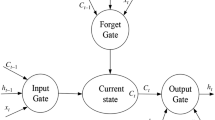Abstract
In recent years, with the breakthrough of big data and deep learning technology in various fields, many scholars have begun to study the stock market time series by using deep learning technology. In the process of model training, the selection of training samples, model structure and optimization methods are often subjective. Therefore, studying these influencing factors is beneficial to provide scientific suggestions for the training of recurrent neural networks and is beneficial to improve the prediction accuracy of the model. In this paper, the LSTM deep neural network is used to model and predict the financial transaction data of Shanghai, and the three types of factors affecting the prediction accuracy of the model are systematically studied. Finally, a high-precision short-term prediction model of financial market time series based on LSTM deep neural network is constructed. In addition, this paper compares BP neural network, traditional RNN and RNN improved LSTM deep neural network. It proves that the LSTM deep neural network has higher prediction accuracy and can effectively predict the stock market time series.












Similar content being viewed by others
References
Liu S, Borovykh A, Grzelak LA et al (2019) A neural network-based framework for financial model calibration. J Math Ind 9(1):9
Cao J, Wang J (2019) Stock price forecasting model based on modified convolution neural network and financial time series analysis. Int J Commun Syst 32(1):e3987
Liu S, Oosterlee CW, Bohte SM (2019) Pricing options and computing implied volatilities using neural networks. Risks 7(1):16
Sezer OB, Ozbayoglu AM (2018) Algorithmic financial trading with deep convolutional neural networks: time series to image conversion approach. Appl Soft Comput 70:525–538
Hien LV, Hai-An LD (2019) Exponential stability of positive neural networks in bidirectional associative memory model with delays. Math Methods Appl Sci 42(18):6339–6357
Khemakhem S, Boujelbene Y (2018) Predicting credit risk on the basis of financial and non-financial variables and data mining. Rev Account Finance. https://doi.org/10.1108/RAF-07-2017-0143
Maciel L, Ballini R, Gomide F (2017) Evolving possibilistic fuzzy modeling for realized volatility forecasting with jumps. IEEE Trans Fuzzy Syst 25(2):302–314
Ahmed M, Afzal H, Majeed A et al (2017) A survey of evolution in predictive models and impacting factors in customer churn. Adv Data Sci Adapt Anal 9(3):1750007
Kim S, Kang M (2019) Financial series prediction using Attention LSTM. arXiv preprint arXiv:1902.10877
Hu R (2019) Deep learning for ranking response surfaces with applications to optimal stopping problems. Quant Finance. https://doi.org/10.1080/14697688.2020.1741669
Tsantekidis A, Passalis N, Tefas A, Kanniainen J, Gabbouj M, Iosifidis A (2018) Using Deep Learning for price prediction by exploiting stationary limit order book features. arXiv preprint arXiv:1810.09965
Demidov RA, Zegzhda PD, Kalinin MO (2018) Threat analysis of cyber security in wireless adhoc networks using hybrid neural network model. Autom Control Comput Sci 52(8):971–976
Hong-Yan R, Wei WU, Qiao-Xuan LI et al (2018) Prediction of dengue fever based on back propagation neural network model in Guangdong, China. Chinese J Vector Biol Control 29(03):221–225
Kraus M, Feuerriegel S (2017) Decision support from financial disclosures with deep neural networks and transfer learning. Decis Support Syst 104:38–48
Fasoli D, Panzeri S (2017) Optimized brute-force algorithms for the bifurcation analysis of a spin-glass-like neural network model. arXiv preprint arXiv:1705.05647
Wang R, Liu H, Feng F et al (2017) Bogdanov-Takens bifurcation in a neutral BAM neural networks model with delays. IET Syst Biol 11(6):163–173
Baiges J, Codina R, Castañar I et al (2019) A finite element reduced order model based on adaptive mesh refinement and artificial neural networks. Int J Numer Methods Eng 121(4):588–601
Blien U, Lindner HG (1993) Neuronale Netze-Werkzeuge für empirische Analysen ökonomischer Fragestellungen Neural/Networks-Tools for Empirical Economics. Jahrbücher für Nationalökonomie und Statistik 212(5–6):497–521
Yang Z, Zhang K, Liang Y, et al Single Image super-resolution with a parameter economic residual-like convolutional Neural Network. 2017
Zhongfu W, Yanhong F (2018) Evaluation model of economic competitiveness based on multi-layer fuzzy neural network. Cluster Comput 39:1–8
Li C, Yu X, Huang T et al (2017) Distributed optimal consensus over resource allocation network and its application to dynamical economic dispatch. IEEE Trans Neural Netw Learn Syst 99:1–12
Author information
Authors and Affiliations
Corresponding author
Ethics declarations
Conflict of interest
The authors have no competing interests.
Additional information
Publisher's Note
Springer Nature remains neutral with regard to jurisdictional claims in published maps and institutional affiliations.
Rights and permissions
About this article
Cite this article
Yan, X., Weihan, W. & Chang, M. Research on financial assets transaction prediction model based on LSTM neural network. Neural Comput & Applic 33, 257–270 (2021). https://doi.org/10.1007/s00521-020-04992-7
Received:
Accepted:
Published:
Issue Date:
DOI: https://doi.org/10.1007/s00521-020-04992-7




